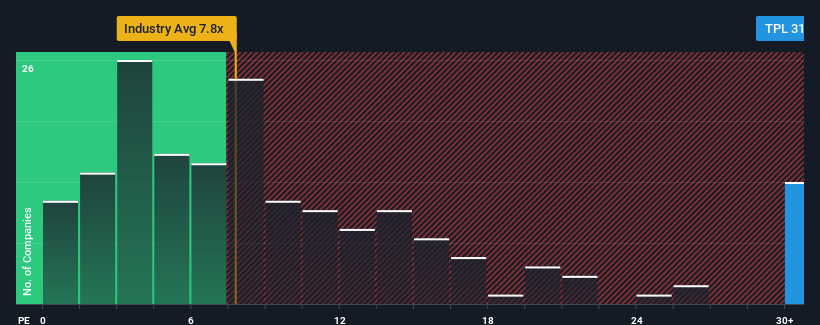- United States
- /
- Oil and Gas
- /
- NYSE:TPL
Texas Pacific Land Corporation's (NYSE:TPL) Business Is Yet to Catch Up With Its Share Price

When close to half the companies in the United States have price-to-earnings ratios (or "P/E's") below 16x, you may consider Texas Pacific Land Corporation (NYSE:TPL) as a stock to avoid entirely with its 31.3x P/E ratio. Although, it's not wise to just take the P/E at face value as there may be an explanation why it's so lofty.
Texas Pacific Land has been struggling lately as its earnings have declined faster than most other companies. One possibility is that the P/E is high because investors think the company will turn things around completely and accelerate past most others in the market. You'd really hope so, otherwise you're paying a pretty hefty price for no particular reason.
View our latest analysis for Texas Pacific Land

What Are Growth Metrics Telling Us About The High P/E?
Texas Pacific Land's P/E ratio would be typical for a company that's expected to deliver very strong growth, and importantly, perform much better than the market.
Retrospectively, the last year delivered a frustrating 7.3% decrease to the company's bottom line. Still, the latest three year period has seen an excellent 98% overall rise in EPS, in spite of its unsatisfying short-term performance. Accordingly, while they would have preferred to keep the run going, shareholders would probably welcome the medium-term rates of earnings growth.
Shifting to the future, estimates from the dual analysts covering the company suggest earnings should grow by 7.0% over the next year. Meanwhile, the rest of the market is forecast to expand by 10%, which is noticeably more attractive.
In light of this, it's alarming that Texas Pacific Land's P/E sits above the majority of other companies. It seems most investors are hoping for a turnaround in the company's business prospects, but the analyst cohort is not so confident this will happen. Only the boldest would assume these prices are sustainable as this level of earnings growth is likely to weigh heavily on the share price eventually.
What We Can Learn From Texas Pacific Land's P/E?
Using the price-to-earnings ratio alone to determine if you should sell your stock isn't sensible, however it can be a practical guide to the company's future prospects.
Our examination of Texas Pacific Land's analyst forecasts revealed that its inferior earnings outlook isn't impacting its high P/E anywhere near as much as we would have predicted. Right now we are increasingly uncomfortable with the high P/E as the predicted future earnings aren't likely to support such positive sentiment for long. This places shareholders' investments at significant risk and potential investors in danger of paying an excessive premium.
A lot of potential risks can sit within a company's balance sheet. You can assess many of the main risks through our free balance sheet analysis for Texas Pacific Land with six simple checks.
Of course, you might also be able to find a better stock than Texas Pacific Land. So you may wish to see this free collection of other companies that have reasonable P/E ratios and have grown earnings strongly.
Valuation is complex, but we're here to simplify it.
Discover if Texas Pacific Land might be undervalued or overvalued with our detailed analysis, featuring fair value estimates, potential risks, dividends, insider trades, and its financial condition.
Access Free AnalysisHave feedback on this article? Concerned about the content? Get in touch with us directly. Alternatively, email editorial-team (at) simplywallst.com.
This article by Simply Wall St is general in nature. We provide commentary based on historical data and analyst forecasts only using an unbiased methodology and our articles are not intended to be financial advice. It does not constitute a recommendation to buy or sell any stock, and does not take account of your objectives, or your financial situation. We aim to bring you long-term focused analysis driven by fundamental data. Note that our analysis may not factor in the latest price-sensitive company announcements or qualitative material. Simply Wall St has no position in any stocks mentioned.
About NYSE:TPL
Texas Pacific Land
Engages in the land and resource management, and water services and operations businesses.
Flawless balance sheet with proven track record.
Similar Companies
Market Insights
Community Narratives



